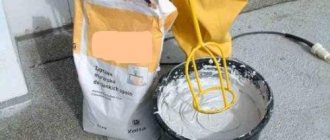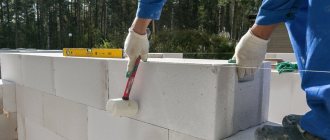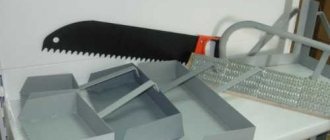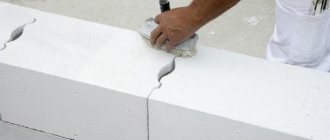Adhesive mixtures and their advantages
Aerated concrete adhesive has several advantages over conventional sand mixtures. When using it, the humidity of aerated concrete blocks does not increase. Hardening occurs without shrinkage, and the adhesive mixture can be used as a putty.
The only point that you should pay attention to when constructing masonry is the setting time. The adhesive for aerated blocks hardens within 10-15 minutes. For this reason, you need to be careful when working and maintain the required speed.
In addition, adhesive for gas concrete has several other advantages:
- due to a more complex composition and polymer-based additives, masonry can be done at sub-zero temperatures,
- no complex preliminary work is required when preparing the mixture,
- constant adhesive composition, which gives the same adhesion properties and the possibility of using thinner seams,
- the solution consumption is four times lower than the sand mixture,
- Thanks to the possibility of using thinner seams, the overall level of heat loss is reduced.
Components
In terms of their composition and the presence of various components, adhesives for aerated concrete are quite diverse. There are also special brands that have various additives that allow them to work at low temperatures. All mixtures for gas silicate blocks are based on the following components:
- fine sand,
- high quality cement,
- modifiers that prevent cracking due to temperature changes,
- polymer-based additives that reduce thermal conductivity and allow the adhesive composition not to freeze at temperatures down to minus 10 degrees.
Frost-resistant adhesive used for masonry in winter contains additional components that increase resistance to low temperatures.
Selection options
There is a wide selection of adhesive compositions on the market designed for laying aerated concrete blocks. When choosing a particular brand, first of all, it is worth considering the conditions under which the masonry will be carried out.
Obviously, for work at low temperatures, frost-resistant mixtures should be purchased. The temperature range for which the adhesive composition is designed is indicated on the packaging. An equally important parameter that people pay attention to when choosing is the setting speed.
Let's not forget that most mixtures begin to set within 10 minutes, and complete hardening occurs within 2 hours. Depending on the brand, these parameters may vary, but these are the average indicators. If you do not have good skills in laying gas blocks, then it is better to purchase glue with a longer hardening time.
Glue consumption per 1 m3
The consumption of mortar for laying one cubic meter of cellular blocks depends on several indicators. To make a more accurate calculation, you can use a special calculator, which is available on many construction websites. Also, the consumption per 1 m3 is calculated according to the formula: S = [(L + H)/L x H] x B x 1.4, where:
| Variable name | Variable value |
| S | total mixture consumption |
| L | block length |
| H | block height |
| B | seam thickness |
| 1.4 | dry glue consumption coefficient per 1 m2 with a 1 mm seam |
Also, the mortar for laying aerated concrete can be consumed more or less depending on the following factors:
- block surface quality,
- climatic conditions under which masonry is carried out,
- tools used during work,
- presence of reinforcement.
To a large extent, the consumption of the solution is also influenced by the level of training of the worker.
Advantages of winter glue
According to reviews from professional builders, winter adhesive for aerated concrete has a number of advantages. It is thanks to a number of advantages that the material has become widespread among private builders and specialized companies.
Saving
Using winter adhesive for aerated concrete can reduce material costs. The adhesive mixture is distinguished by its plasticity. This makes it possible to make the seams thin, which, in turn, reduces the consumption of mortar.
Construction strength
A specialized solution penetrates deep into the small pores of the panels, forming, after complete hardening, a monolithic wall. This structural element is characterized by strength and durability.
Advantages of adhesive for aerated concrete blocks
Low thermal conductivity
Due to the fact that the thickness of the seams is approximately 2–3 millimeters, the size of the “cold bridges” becomes minimal. Low thermal conductivity of joints is achieved due to modifiers included in the winter masonry mortar.
Applying winter glue to aerated concrete
Smooth masonry
The clear geometry of aerated concrete blocks together with plastic mortar allows the construction of smooth walls. This will further help reduce the consumption of putty mixture.
Table of laying blocks with glue
Frost resistance
The composition of winter adhesive for aerated concrete allows masonry to be carried out at temperatures down to -10° C. In this case, the solution must be mixed at room temperature.
Important: the temperature of the solution should not fall below 0 ° C, this may disrupt its physical properties.
When laying aerated concrete blocks in frosty conditions, they must be clean and dry. The presence of ice and dirt on them is not allowed.
Frost resistance of adhesive for aerated concrete blocks
Fast hardening
The winter composition is characterized by a longer curing time compared to the summer one, and also a shorter curing time compared to cement mortar. The finished mixture can be used for 3 hours. During this time, it will not lose its properties. Complete hardening of the solution occurs 24 hours after laying. This allows you to significantly speed up the construction process.
Indicators of winter adhesive for aerated concrete
Easy to use
Glue for aerated concrete is easily brought into working condition. Even a person far from construction can quickly prepare the solution. This reduces the worker’s physical fatigue and speeds up the construction process.
Preparation of mortar for aerated concrete
The technology for preparing an adhesive solution with your own hands is quite simple. Water is poured into the preparation container in the required volume and the dry mixture is gradually poured in with constant stirring. The required proportions can be found on the packaging.
Mixing the solution can be done manually, but the most convenient option is to use a special drill attachment. It is necessary to achieve complete homogeneity of the mass. Next, the finished solution is allowed to stand for about 10 minutes and mixed again.
Kneading must be done in small portions, since the glue sets quickly enough. During operation, the mass is periodically mixed, while adding water to the finished solution is strictly prohibited. The finished solution begins to be applied to the second row, since the sand mixture is laid on the first to achieve initial leveling.
How to prepare the solution yourself?
Mixtures from different manufacturers differ in their composition. Therefore, it is better to use the cooking recipe indicated on the package. Below is a preparation method that is suitable for most mixtures, but is not universal.
Winter glue consumption
You need to prepare aerated concrete adhesive, water and a mixing container. A durable metal or plastic container will do. The water should be warm, but not hot. It is better to take water at room temperature. For 10 kilograms of bag contents you will need approximately 2–2.5 liters of water. To avoid the appearance of lumps, the glue must be poured into the water in small portions, while stirring continuously. Do not pour water into the container with the mixture. This will form lumps that will be very difficult to break.
The solution can be mixed either manually or using special devices. By stirring manually, you can, if necessary, obtain a small portion of the finished product. For large volumes it is better to use a construction mixer. If it is not available, you can use a specialized drill attachment. The solution is stirred at low speed until it reaches a homogeneous consistency.
When using the solution, you need to maintain its temperature within 10 degrees. In frosty operating conditions this is difficult to do. Therefore, you need to prepare the glue in small portions. One such portion should be enough for 30 minutes of work.
Tool for applying glue to aerated concrete
The tools used for laying aerated concrete blocks use quite a few simple devices. The main ones are:
- trowel,
- notched spatula,
- toothed bucket,
- carriage.
It’s worth saying more about the carriage. It belongs to professional tools, and the purchase of this device is justified if there are large and constant volumes of work. The carriage allows you to maintain a constant thickness of the seam and simplifies the application of glue due to a special container.
Which adhesive is best for silicate: selection criteria
When choosing a binding material for laying porous blocks, it is recommended to be guided by several criteria:
- manufacturer's reputation. Well-known suppliers of construction resources value their own reputation and carefully control the quality of the materials they produce. If you are confused by the high cost of a well-known brand product, remember the proverb “the miser pays twice.” To buy branded products at competitive prices, you should use the services of branded showrooms and participate in company promotions;
- storage conditions and packaging. The dry adhesive concentrate is stored in a dry, ventilated area. Factors such as high humidity or damaged packaging indicate low quality products. You should not buy the mixture for laying gas silicate in bulk, as this is fraught with low quality of the material;
- you should give preference to products from a manufacturer that produces both porous concrete blocks and masonry adhesive;
- Before purchasing a mixture for laying gas silicate, it is necessary to calculate the material consumption.
The main parameter when calculating the solution consumption per 1 m³ of base is the thickness of the binder layer. If the layer thickness is no more than 3 mm per 1 m³ of surface, 8-9 kg of working composition is required.
How to lay aerated concrete blocks - step-by-step instructions
Laying walls made of aerated concrete blocks is somewhat different from work carried out using sand mortars. The main rule that is observed during work is to apply the adhesive only to a carefully prepared surface of the block. It should be free of dust, ice and other foreign substances. The main stages of work consist of the following steps:
- inspection and cleaning of blocks,
- preparation of adhesive composition,
- applying the solution to the blocks,
- installation of blocks and their alignment,
- cleaning masonry from excess glue.
It is worth noting that preliminary moistening of aerated concrete blocks during work is not required. However, in hot weather it may be necessary to slow down and stabilize the hardening of the mortar. It is advisable to cover the finished masonry with a tarpaulin or burlap until the glue has completely set.
Hardening accelerators for aerated concrete
In order for aerated blocks to harden faster and, accordingly, the productivity of the line to be higher due to faster mold turnover, hardening accelerators are added to the solution. Set accelerators reduce the minimum curing time required to maintain concrete in a porous state.
Traditionally, sodium sulfate or calcium chloride is used to reduce the time from pouring to cutting. These additives are the cheapest, but in some cases their use has the following disadvantages:
- increased shrinkage,
- the occurrence of efflorescence on blocks,
- aggressive effect on reinforcing metal elements,
- uneven hardening of the mass.
A suitable hardening accelerator is selected individually and depends on the quality of other components, manufacturing conditions and the skill of the technologists.
Special additives for aerated concrete
In addition to the listed additives for aerated concrete, many other modifiers are produced.
- Antibacterial. Such additives prevent gas blocks from being damaged by fungi and mold, increasing the durability of the masonry.
- Additives that prevent the appearance of stains and dirt on blocks.
- Eco-friendly supplements made from organic materials.
- Complex additives that combine several properties.
| Using additives to improve the quality of aerated concrete and give it additional properties can be a good marketing advantage or even a unique selling proposition for your company. |
By purchasing equipment for the production of aerated concrete, you receive unlimited consultations from technologists, assistance in debugging the technology and marketing materials to promote your products.
Specifics of work in winter
Work on the construction of walls in most cases does not stop with the end of the warm period. Adhesive compositions for foam blocks allow masonry to be carried out even in winter due to special silicate and polymer additives.
Even when using glue with frost-resistant components, certain rules should be followed. The solution must be kept warm during operation, and its temperature should not fall below zero degrees. The entire prepared glue solution is used within 30 minutes, and it is better to insulate the container in which it is located.
The main advantages of glue over mortar
To ensure durability and high-quality adhesion of the blocks, it is recommended to use a special adhesive composition. The use of the classic version with cement-sand mortar entails a number of problems that can arise both during construction and during the operation of the building:
- the appearance of holes and cracks, loose joining of blocks;
- peeling of blocks after the solution hardens, resulting in loss of strength.
In addition to these nuances, difficulties arise with preparing the composition: it needs to be applied in a much larger layer than glue, and accordingly, more time and materials will be required to prepare the composition.
Compared to the classic mixture, special gas silicate glue has a number of advantages:
- Small expense. The technology for working with such glue involves applying it in a very thin layer.
- Resistant to temperature changes.
- Guaranteed wall protection against heat loss.
- Strength is many times higher than when using a classic mixture
- The special components of the glue ensure its rapid hardening and adhesion of the blocks.
What glue is used for gas silicate blocks: description of work
A wide variety of materials are used in modern construction. Recently, one of the most popular are gas silicate blocks, which look beautiful, are relatively inexpensive and are easy to install. In addition, the material meets all building codes and perfectly retains heat inside buildings. For its laying, special glue is often used. Next, we will consider how to lay gas silicate blocks on glue, as well as the glue consumption for gas silicate blocks per 1 m3.
Adhesive for gas silicate blocks
Types of mixtures for laying aerated concrete and application features
The market offers seasonal varieties of dry adhesive concentrates based on white and gray Portland cement, as well as compositions in foam format in cans:
- The white version of the building resource - summer adhesive for gas silicate - is intended for use in the warm season. The composition owes its color to a white Portland cement base. The attractive appearance of the fastening solution makes it popular in interior work, which makes it possible to save on finishing.
- Gray glue is considered winter, although it is a universal mixture for laying aerated concrete in any season. The composition contains antifreeze additives and is intended for use at temperatures within a wide range of up to -10°C.
The process of drying masonry at elevated ambient temperatures is fraught with the risk of microcracks in the bonding layer, and as a result, the thermal conductivity characteristics of aerated concrete deteriorate.
Porous concrete blocks are known for their inertness to environmental temperature changes. In this case, the correct technology for applying the adhesive composition while strictly following the manufacturer’s instructions plays an important role.
What is recommended when working with winter composition for laying gas silicate:
- a heated room should be used to store bags of dry concentrate;
- the preparation of the solution is carried out in a warm room, the temperature of the water for diluting the dry mixture should not be lower than +20°C;
- working solution temperature – not lower than +10°C;
- The prepared solution is used for its intended purpose within half an hour.
Freezing of moisture is fraught with deterioration in the quality of the seam, so during winter work the aerated concrete masonry should be covered with a tarpaulin.
Adhesive foam for gas silicate is an innovative solution in this segment. The construction resources market offers an adhesive composition for porous concrete blocks in the format of foam in cylinders, for application of which a special device in the form of a construction gun is used.
Flow calculation technology
If all the rules for producing the mixture and applying it to the blocks have been followed, then its consumption can be carried out in the following ways: glue is sold in bags weighing 25 kg. This value was not chosen by chance by the manufacturer, because the weight of dry glue is optimal for laying 1 m3 of blocks. Thanks to this, the consumption of the composition will be very easy to carry out. Let's look at this in more detail using an example:
- After you have calculated everything, it turns out that to lay the walls and partitions you will need, say, 63 m3 of aerated concrete.
- If the thickness of the laying layer is 3 mm, then the consumption of the adhesive composition per 1 m3 of blocks will be 63 bags.
- When the thickness of the seam between the laying blocks is 2 mm, the amount of glue consumed will decrease by 5 kg. Then for 63 m3 you will have to spend 20x63 = 1260 kg of mixture. Next, 1260/25= 50, 4 bags. Round up and get 51 bags of glue.
- The obtained value is the smallest amount of glue that needs to be spent to erect a building, the construction of which involves the use of 63 m3 of aerated concrete. When the price is known, you can simply find out the cost of the adhesive solution.
In the video - winter glue for gas silicate blocks:
If you use a cement-sand mortar for installation for such a volume of work, then here you will need 2 dm 3 of glue. Thus, 1 cube of the mixture will be used to lay 4 cubes of blocks. To prepare a cube of mortar, you will need 7 bags of cement. The price will also have to include the price of sand, purchase or rental of a concrete mixer. Taking all this into account, you can obtain the amount of mixture required to lay 1 m3 of aerated concrete: 7/5 = 1.4 bags.
Tile adhesive technical characteristics and its composition are described in the article.
You can learn about the technical characteristics of Eunice tile adhesive by reading the article.











